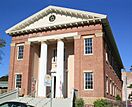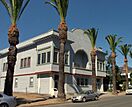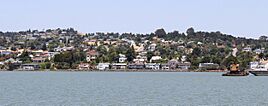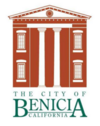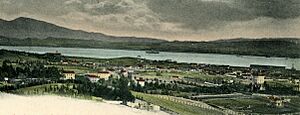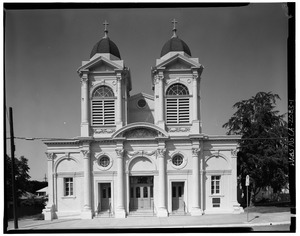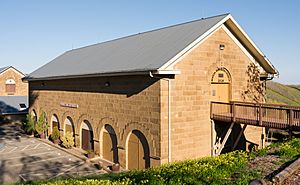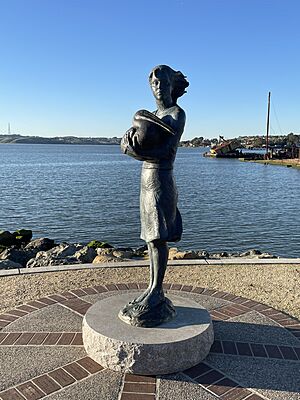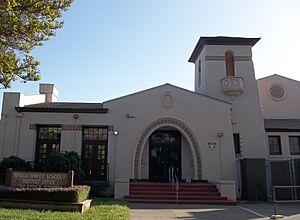Benicia, California facts for kids
Quick facts for kids
Benicia
|
|||||
|---|---|---|---|---|---|
| City of Benicia | |||||
|
Portuguese Hall of Benicia
View from the Carquinez Strait
Benicia Arsenal clocktower
Downtown Benicia
Old Arsenal Blacksmith
|
|||||
|
|||||
| Motto(s):
"It’s better in Benicia"
|
|||||
| Country | United States | ||||
| State | California | ||||
| County | Solano | ||||
| Incorporated | March 27, 1850 | ||||
| Area | |||||
| • Total | 14.12 sq mi (36.57 km2) | ||||
| • Land | 12.81 sq mi (33.19 km2) | ||||
| • Water | 1.31 sq mi (3.39 km2) 17.75% | ||||
| Elevation | 26 ft (8 m) | ||||
| Population
(2020)
|
|||||
| • Total | 27,131 | ||||
| • Density | 2,117.46/sq mi (817.56/km2) | ||||
| Time zone | UTC−8 (Pacific) | ||||
| • Summer (DST) | UTC−7 (PDT) | ||||
| ZIP Code |
94510
|
||||
| Area code | 707 | ||||
| FIPS code | 06-05290 | ||||
| GNIS feature IDs | 0277472, 2409833 | ||||
Benicia is a city in Solano County, California. It is located on the north side of the Carquinez Strait in the San Francisco Bay Area. Benicia was once the capital of California for about a year, from 1853 to 1854. In 2020, about 27,131 people lived there. Benicia is just east of Vallejo and across the strait from Martinez.
Contents
History of Benicia
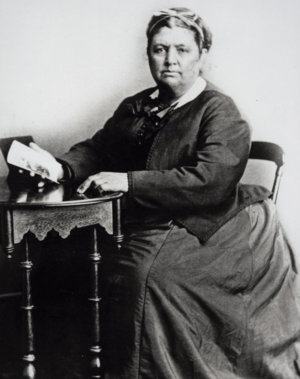

The city of Benicia was started on May 19, 1847. It was founded by Dr. Robert Semple, Thomas O. Larkin, and General Mariano Guadalupe Vallejo. General Vallejo gave them the land in December 1846. The city was named after his wife, Francisca Benicia Carillo de Vallejo. She was from an important family in California.
General Vallejo wanted to name the city "Francisca" after his wife. But another city, "Yerba Buena," changed its name to "San Francisco." So, they used her second name, Benicia, instead. William Tecumseh Sherman once said that Benicia was the "best natural site for a commercial city" in the area.
In February 1848, news about gold found at Sutter's Mill first spread in a Benicia tavern. This event helped start the famous California Gold Rush. Benicia then became a popular stop for people traveling to the gold fields.
Early City Life and Government
In March 1850, Benicia became one of the first cities in California to be officially formed. This happened just one month after Sacramento. Benicia was also the first county seat for Solano County. The lower part of the Benicia Masonic Hall, built in 1850, was used as the county courtroom. Later, in 1858, the county seat moved to Fairfield.
In 1853, Benicia became the third place to serve as the California State capital. Before Benicia, the capital was in San Jose and then Vallejo. Benicia's newly built city hall was California's capitol building from February 11, 1853, to February 25, 1854. After that, the government moved to Sacramento, which has been the capital ever since. Today, the old capitol building is part of the Benicia Capitol State Historic Park. It is the only remaining building from California's early capitals before Sacramento.
The first campus of Mills College started in Benicia in 1852. It was called the Young Ladies Seminary. This was the first college for women west of the Rocky Mountains. It moved to Oakland in 1871.
From 1860 to 1861, Benicia was part of the Pony Express route. If riders missed their boat in Sacramento, they would go to Benicia. From there, they would take a ferry across to Martinez. The Pacific Mail Steamship Company, one of California's first companies, built a large shipyard in Benicia. The famous shipbuilder Matthew Turner also started his shipyard in Benicia in 1883.
Benicia became an important place for storing and shipping wheat. It was also home to the United States Army's Benicia Arsenal. This was a military storage and supply base.
On December 1, 1879, the Central Pacific Railroad changed its train route. Trains from Sacramento to Oakland began to pass through Benicia. They used a large train ferry to cross the Carquinez Strait from Benicia to Port Costa. The world's largest ferry, the Solano, carried entire trains across the strait. Later, an even bigger ferry called the Contra Costa joined it.
On June 5, 1889, a famous boxing match happened near Benicia. Boxers James J. Corbett and Joe Choynski fought on a barge off the coast. The fight lasted 28 rounds! A plaque near Southampton Bay now remembers this event.
Benicia in Modern Times

In 1901, the world's first long-distance power line crossed the Carquinez Strait near Benicia. In the early 1900s, California's wheat production went down. Also, the Southern Pacific Railroad opened a bridge to Martinez in 1930. This bridge replaced the ferry crossing and the Benicia train station. Because of these changes, Benicia's economy slowed down.
However, during World War II, Benicia saw a big economic boost. Its population doubled to about 7,000 residents.
A large fire on March 22, 1945, destroyed many businesses. It burned down half a city block, including an old brewery and the Solano Hotel. The flames briefly threatened the old state capitol building, which is now a historical landmark. Luckily, a small roof fire was put out quickly, and the capitol was not badly damaged.
Two major events in the early 1960s completely changed Benicia. First, the Benicia Arsenal closed between 1960 and 1964. This removed Benicia's main source of jobs. However, city leaders turned the Arsenal land into an industrial park. This new park eventually brought in more money for the city than the Army had. Second, the Benicia–Martinez Bridge was finished in 1962. This bridge made it easier for people to live in Benicia and work in San Francisco or Oakland. New homes started to be built in the Benicia hills in the late 1960s.
Northeast of the town, an oil refinery was built. It was finished in 1969 by Humble Oil, which later became Exxon Corporation. In 2000, Valero Energy Corporation bought the refinery.
Between 1970 and 1995, Benicia's population grew steadily. About 1,000 new people moved there each year. The city changed from a small town of 7,000 people to a larger suburb of 27,000.
Geography of Benicia
Benicia is located on the north side of the Carquinez Strait. The city covers about 15.7 square miles (40.7 square kilometers) in total. About 12.9 square miles (33.4 square kilometers) is land, and 2.8 square miles (7.3 square kilometers) is water. This means that about 17.75% of Benicia's area is water.
Population and People
| Historical population | |||
|---|---|---|---|
| Census | Pop. | %± | |
| 1880 | 1,794 | — | |
| 1890 | 2,361 | 31.6% | |
| 1900 | 2,751 | 16.5% | |
| 1910 | 2,360 | −14.2% | |
| 1920 | 2,693 | 14.1% | |
| 1930 | 2,913 | 8.2% | |
| 1940 | 2,419 | −17.0% | |
| 1950 | 7,284 | 201.1% | |
| 1960 | 6,070 | −16.7% | |
| 1970 | 7,349 | 21.1% | |
| 1980 | 15,376 | 109.2% | |
| 1990 | 24,437 | 58.9% | |
| 2000 | 26,865 | 9.9% | |
| 2010 | 26,997 | 0.5% | |
| 2020 | 27,131 | 0.5% | |
| U.S. Decennial Census | |||
Benicia's Population in 2010
In 2010, the United States Census reported that Benicia had 26,997 people. Most of the people living in Benicia were White (72.5%). There were also African American (5.6%), Native American (0.5%), Asian (11.1%), and Pacific Islander (0.4%) residents. About 12.0% of the population was Hispanic or Latino.
Almost all of the people (99.9%) lived in homes. There were 10,686 households in total. About 33.8% of these homes had children under 18 living there. The average household had 2.52 people. The average family size was 3.02 people.
The population included 23.4% under 18 years old and 12.5% who were 65 or older. The average age in Benicia was 42.9 years. For every 100 females, there were about 92.7 males.
Benicia's Population in 2000
In 2000, there were 26,865 people living in Benicia. There were 10,328 households and 7,239 families. The population density was about 2,082.6 people per square mile.
The racial makeup of the city was mostly White (78.89%). About 9.02% of the people were Hispanic or Latino. There were also Asian (7.56%), Black or African American (4.82%), Native American (0.60%), and Pacific Islander (0.29%) residents.
About 36.7% of households had children under 18. The average household size was 2.60 people, and the average family size was 3.10 people.
In 2000, 27.1% of the population was under 18. About 9.3% were 65 years or older. The average age was 39 years. The average income for a household was $67,617. For a family, it was $77,974.
Economy and Jobs
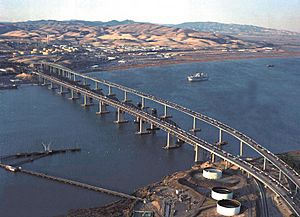
Benicia has a strong economy with several important employers. These companies provide many jobs for the city's residents.
Major Employers in Benicia
Here are some of the top employers in Benicia, based on a 2011 report:
| # | Employer | # of Employees |
|---|---|---|
| 1 | Valero | 516 |
| 2 | Benicia Unified School District | 465 |
| 3 | Dunlop Manufacturing | 248 |
| 4 | City of Benicia | 229 |
| 5 | CytoSport | 221 |
| 6 | Bio-Rad Laboratories | 209 |
| 7 | Coca-Cola Refreshments | 162 |
| 8 | Valley Fine Foods | 133 |
| 9 | Pepsi Beverages Company | 119 |
| 10 | 1-800 Radiator & A/C | 106 |
Arts and Culture in Benicia
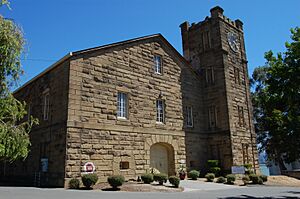
Benicia has a lively arts and culture scene. Many events and organizations help make the city a creative place.
Art and Exhibitions
Arts Benicia is a group that helps support art in the city. They offer art shows, classes, and programs for both artists and the community. You can find them at the Benicia Arsenal. They have art exhibitions and public art openings throughout the year. They also host the Benicia Artists Open Studios event in the spring. In the fall, they have an Annual Benefit Art Auction. They also offer art classes for both kids and adults.
Festivals and Parades
- Arts in the Park is an annual summer art festival held in Benicia City Park.
- Benicia Peddler's Fair is one of the biggest street fairs in Northern California. It started in 1963 with local shops selling items outside a church.
- Fourth of July Parade is traditionally held on July 3. This parade goes all the way down First Street. It usually includes music, dancing, floats, horses, clowns, and live entertainment.
Portuguese Holy Ghost Festival
On the fourth Sunday in July, Benicia's Portuguese community celebrates the feast of the Holy Ghost. This tradition comes from Queen St. Isabel of Portugal, who was known for helping the poor. The festival begins with a parade to St. Dominic's Church, followed by a special Mass. After that, there's an auction and a dance. The Holy Ghost Parade celebrated its 100th year in Benicia in 2007.
Sailing Community
Benicia is a very active sailing community. Many people enjoy sailing from the Benicia Marina. There are also organized sailing events and competitions. During the summer, the Benicia Yacht Club hosts a yacht racing competition on Thursday evenings. The Yacht Club also helps organize the annual Jazz Cup regatta. They also have a Youth Sailing Program that teaches young people how to sail.
Education in Benicia
The Benicia Unified School District manages all the public schools in the city.
- Elementary Schools
- Matthew Turner Elementary School (named after a famous local shipbuilder)
- Robert Semple Elementary School (named after one of the city's founders)
- Mary Farmar Elementary School
- Joe Henderson Elementary School (named after a local educator)
- Middle Schools
- Benicia Middle School
- High Schools
- Benicia High School
- Liberty High School
Transportation in Benicia
Benicia does not have its own train system because a railroad bridge opened in 1930. However, you can use bus transportation through SolTrans and SolanoExpress. These buses stop at the Benicia Park and Ride. From there, you can connect to the Walnut Creek BART station.
The Benicia–Martinez Bridge allows cars and trains to cross the Carquinez Strait. It also has lanes for bicycles and walkers, which opened in August 2009.
The Benicia Marina is a full-service marina located near downtown. It offers a place to get fuel, pump out waste, and launch boats. It also has a general store, laundry, restrooms, and showers for boaters.
Famous People from Benicia
Many interesting people have lived in or are connected to Benicia.
Artists and Designers
- Robert Arneson (1930–1992), a sculptor and art professor.
- Linda Fleming (born 1945), a sculptor and art professor.
- Addison Mizner (1872–1933), a famous architect, was born in Benicia.
- Manuel Neri (1930–2021), a sculptor who had a studio in Benicia for many years.
- Guillermo Wagner Granizo (1923–1995), a ceramic tile artist, moved to Benicia in 1980.
Sports Figures
- Austin Carr, an NFL football player.
- John C. Heenan, a boxer known as "The Benicia Boy."
- Willie Calhoun, a professional baseball player.
Writers
- Stephen Vincent Benét, author of "The Devil and Daniel Webster" and other works. He lived in the Arsenal as a child.
- James Lloyd Breck, an Episcopalian priest.
- Jack London, a famous author, worked in the local fishing industry and started writing while in Benicia.
- Wilson Mizner, a playwright, was born in Benicia.
- Elsie Robinson (1883–1956), a journalist and writer known for her column “Listen, World!”. She was born in Benicia.
Sister City
Benicia has one sister city, which helps build friendships between different places.
 – Tula de Allende, Hidalgo, Mexico
– Tula de Allende, Hidalgo, Mexico
See also
 In Spanish: Benicia para niños
In Spanish: Benicia para niños


